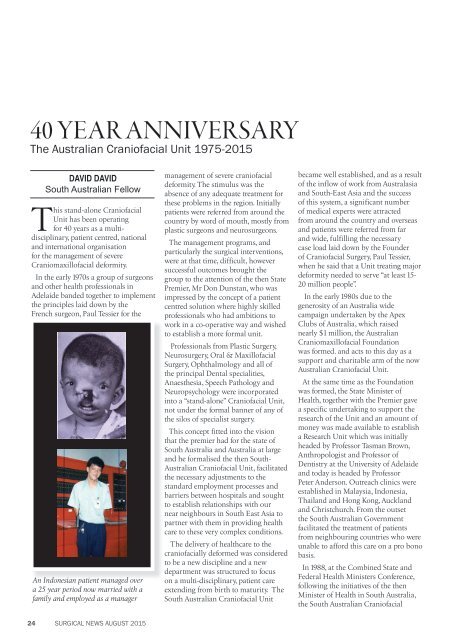SURGICAL NEWS
b6dhb_f
b6dhb_f
- No tags were found...
You also want an ePaper? Increase the reach of your titles
YUMPU automatically turns print PDFs into web optimized ePapers that Google loves.
40 YEAR ANNIVERSARY<br />
The Australian Craniofacial Unit 1975-2015<br />
DAVID DAVID<br />
South Australian Fellow<br />
This stand-alone Craniofacial<br />
Unit has been operating<br />
for 40 years as a multidisciplinary,<br />
patient centred, national<br />
and international organisation<br />
for the management of severe<br />
Craniomaxillofacial deformity.<br />
In the early 1970s a group of surgeons<br />
and other health professionals in<br />
Adelaide banded together to implement<br />
the principles laid down by the<br />
French surgeon, Paul Tessier for the<br />
An Indonesian patient managed over<br />
a 25 year period now married with a<br />
family and employed as a manager<br />
management of severe craniofacial<br />
deformity. The stimulus was the<br />
absence of any adequate treatment for<br />
these problems in the region. Initially<br />
patients were referred from around the<br />
country by word of mouth, mostly from<br />
plastic surgeons and neurosurgeons.<br />
The management programs, and<br />
particularly the surgical interventions,<br />
were at that time, difficult, however<br />
successful outcomes brought the<br />
group to the attention of the then State<br />
Premier, Mr Don Dunstan, who was<br />
impressed by the concept of a patient<br />
centred solution where highly skilled<br />
professionals who had ambitions to<br />
work in a co-operative way and wished<br />
to establish a more formal unit.<br />
Professionals from Plastic Surgery,<br />
Neurosurgery, Oral & Maxillofacial<br />
Surgery, Ophthalmology and all of<br />
the principal Dental specialities,<br />
Anaesthesia, Speech Pathology and<br />
Neuropsychology were incorporated<br />
into a “stand-alone” Craniofacial Unit,<br />
not under the formal banner of any of<br />
the silos of specialist surgery.<br />
This concept fitted into the vision<br />
that the premier had for the state of<br />
South Australia and Australia at large<br />
and he formalised the then South-<br />
Australian Craniofacial Unit, facilitated<br />
the necessary adjustments to the<br />
standard employment processes and<br />
barriers between hospitals and sought<br />
to establish relationships with our<br />
near neighbours in South East Asia to<br />
partner with them in providing health<br />
care to these very complex conditions.<br />
The delivery of healthcare to the<br />
craniofacially deformed was considered<br />
to be a new discipline and a new<br />
department was structured to focus<br />
on a multi-disciplinary, patient care<br />
extending from birth to maturity. The<br />
South Australian Craniofacial Unit<br />
became well established, and as a result<br />
of the inflow of work from Australasia<br />
and South-East Asia and the success<br />
of this system, a significant number<br />
of medical experts were attracted<br />
from around the country and overseas<br />
and patients were referred from far<br />
and wide, fulfilling the necessary<br />
case load laid down by the Founder<br />
of Craniofacial Surgery, Paul Tessier,<br />
when he said that a Unit treating major<br />
deformity needed to serve “at least 15-<br />
20 million people”.<br />
In the early 1980s due to the<br />
generosity of an Australia wide<br />
campaign undertaken by the Apex<br />
Clubs of Australia, which raised<br />
nearly $1 million, the Australian<br />
Craniomaxillofacial Foundation<br />
was formed. and acts to this day as a<br />
support and charitable arm of the now<br />
Australian Craniofacial Unit.<br />
At the same time as the Foundation<br />
was formed, the State Minister of<br />
Health, together with the Premier gave<br />
a specific undertaking to support the<br />
research of the Unit and an amount of<br />
money was made available to establish<br />
a Research Unit which was initially<br />
headed by Professor Tasman Brown,<br />
Anthropologist and Professor of<br />
Dentistry at the University of Adelaide<br />
and today is headed by Professor<br />
Peter Anderson. Outreach clinics were<br />
established in Malaysia, Indonesia,<br />
Thailand and Hong Kong, Auckland<br />
and Christchurch. From the outset<br />
the South Australian Government<br />
facilitated the treatment of patients<br />
from neighbouring countries who were<br />
unable to afford this care on a pro bono<br />
basis.<br />
In 1988, at the Combined State and<br />
Federal Health Ministers Conference,<br />
following the initiatives of the then<br />
Minister of Health in South Australia,<br />
the South Australian Craniofacial<br />
24 <strong>SURGICAL</strong> <strong>NEWS</strong> AUGUST 2015


